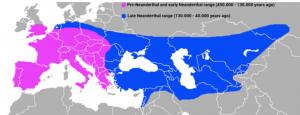Archaeoastronomy is concerned with “how people of the past understood the stars and the sky” (Winston 2012). From the earliest hominids to modern stargazers, there has always been a fascination with the night sky. This fascination has led to the integration of stars and celestial events into ancient religions, stories, architecture, agriculture, and even societal values (Winston 2012).
Specifically in Native American cultures, ancient myths have been noted to be quite similar among different tribes under the same sky. Many creation stories follow the form of doubles. For example, in Cahokia culture, there is the important duality of the Morning Star and the Evening Star. Many other Native American cultures had a version of this duality, including male vs female, upper world vs lower world, light vs dark, and civility vs chaos (Figure 1). There are references to this theme of twins in Mississippi, New Mexico, New York, and even North Carolina, suggesting that though these tribes were geographically distant from each other, they all arrived at similar conclusions under the unifying blanket of the night sky (Pauketat 2010, 94-95).
Specific celestial events such as the 1054 A.D. supernova provide even greater insight into the importance of astronomy on ancient civilizations. This supernova was visible for close to two years and marked a turning point for several Native societies. It was “visible both night and day around the world” (Pauketat 2010, 20) and was “four times brighter than Venus” (Pauketat 2010, 20). In Cahokia culture, this marked a turning point from Old Cahokia to New Cahokia, termed a “big bang moment” by archaeologists who studied the Mississippian site. Small farm villages were razed to the ground to make room for a new city filled with plazas and mounds with religious and political structures on top. The radiocarbon dating of New Cahokia puts the formation of the city within four years of the supernova, indicating its contribution to the incredible changes (Pauketat 2010, 23). In New Mexico, another Native society, the Anasazi, represented the supernova in cave drawings, indicating it was a major moment in their history worth documenting it. The Hopi connected astronomical events with their belief in multiple worlds. They believed that the transition from one world to another was indicated by the appearance of a blue star. This could have been the 1054 supernova, as the crab nebula (Figure 2) that developed was characterized by a blue color (Winston 2012).
Archaeoastronomy provides a way of looking into the past through the lens of constellations and celestial events. This interconnected relationship between the stars and humans has resulted in many momentous changes in societies across America. This field of study provides insight into different culture’s religions and values in ways that other methods fall short.
References:
Pauketat, Timothy
2010 In Cahokia Ancient America’s Great City on the Mississippi, edited by Colin Calloway, pp. 20-95. Penguin Group, London
Winston, Grady
2012 Astronomy and Mythology in Native American Culture. Legendsofamerica.com
https://www.legendsofamerica.com/na-astronomyculture/
Links of Interest:
https://www.grace.umd.edu/~tlaloc/archastro/cfaar_as.html
https://www.jstor.org/stable/41053196?seq=1#metadata_info_tab_contents
https://ecuip.lib.uchicago.edu/diglib/science/cultural_astronomy/cultures_anasazi-3.html




